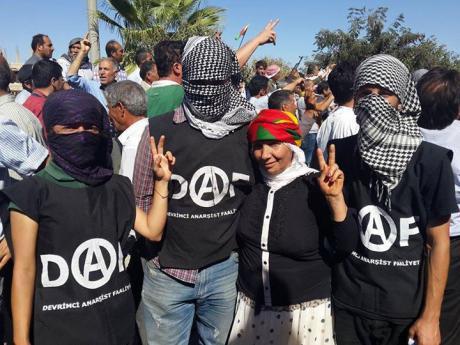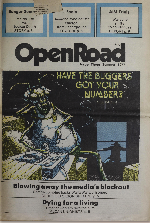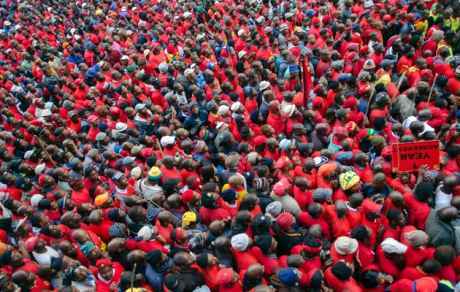Previously, I posted material by David Graeber and Janet Biehl on the libertarian social revolution in Rojava, the region in northern Syria where the city of Kobane was under attack by ISIS militants. Here, I reproduce an edited version of a January 2015 radio interview with members of the Turkish revolutionary anarchist group, DAF (Revolutionary Anarchist Action), regarding the situation in Rojava and the support Turkish anarchists have been providing there. In Volume Three of Anarchism: A Documentary History of Libertarian Ideas, I included material by Kurdish anarchists from the 1990s proposing a social revolutionary anarchist approach for the Kurds, and an interview Janet Biehl did regarding the movement for “communal democracy” among the Kurds.
The people living in the [Rojava] region are mostly Kurds, who have been living there for hundreds of years. This region has never been represented by a state. Because of that, the people of the region have been in struggle for a very long time. The people are very diverse in terms of ethnicity and religion: there are Kurdish people, Arabic people, Yazidi people, and more. One of the major Kurdish people’s organizations in Turkey and Iraq is the PKK, and the PYD in Syria is in the same line with the PKK. As for military organizations, there are the YPJ and YPG, the men’s and women’s organizations. Against these organizations stand ISIS, the Islamic gangs, in which Al Nusra is involved. These are the radical Islamists. There is also the Free Syrian Army, a coalition of many different groups; they are supported by the capitalist system, but they are not as radical as ISIS. And there is the Turkish state, and Assad’s Syrian state, who are on the attack. In northern Iraq, there is also a Kurdish state, under the KDP of Barzani, which is ideologically the same as the Turkish state, but ethnically a bit different.
The PKK has a bad reputation in the West because of their past. Twenty years ago, when it was founded, it was a Marxist-Leninist group. But a few years ago, it changed this completely and denounced these ideas, because the ideas of their leader changed and so did the people. They went towards a more libertarian ideology after reading the works of Murray Bookchin and on account of some other factors in the region. To understand the situation today, it is also important that in the beginning, the PKK was not so ideological. It did not grow up as an ideological movement, but as a people’s movement. This is another factor explaining how it has developed in this direction.
The Rojava revolution was proclaimed two years ago. Three cantons declared their independence from the state, from Assad’s regime. They didn’t want any kind of involvement with any of the internationally supported capitalist powers. This successfully opened up a third front in the region. It was a moment when the states in the region lost power.
This began as a project of the Kurdish struggle. It involves directly democratic practices like people’s assemblies, and it is focused on ethnic diversity, power to the people, and women’s liberation, which is a big focus of the Kurdish movement in general, not just in Rojava. They formed their own defense units, which are voluntary organizations just made up of the people who are living there.
DAF [Revolutionary Anarchist Action] advocates a revolutionary perspective; we call ourselves revolutionary anarchists because we want anarchism to be socially understood in our region, because in this region anarchism doesn’t have any tradition or history. Our first aim is to spread the ideals of anarchism into the social fabric of our society, and for us the practice is more important than theory. Or rather, we build our theory on our practice as revolutionary anarchists.
We are against all forms of oppression. We focus on workers’ movements and people’s movements that are oppressed due to ethnicity, we stand in solidarity against women’s oppression, and we are active in all of those movements. In Rojava, we were in touch with participants in the revolution since it started; when the resistance began in Kobanê, we immediately went to the region; our comrades organized solidarity actions on both sides of the border. We still have people there on a rotating basis, and we are still organizing actions. For example, recently, our women’s group organized an action in which they called for conscientious objection in support of the Kobanê resistance.
The Turkish state has been attacking Kobanê from the west. In their discourse, the Turkish state sounds like they are against ISIS, but in practice it permits material resources, arms, and people to pass through the border, and it has been attacking the villages on the border. These villages are not very separate from Kobanê; it’s the same families and a lot of people from Kobanê pass through there when they are injured or if they want to join the struggle from the Turkish side of the border. So our comrades are staying in the villages and participating in all the actions in the communes, doing logistical support for the refugees and for injured people.
Lately, other parts of Rojava have been attacked. If you remember months ago when ISIS first attacked the Yazid people, the Yazids were forced to flee from their cities, and they were saved by the YPD fighters. Afterwards, ISIS was repelled. Last week, the Yazid people have formed their own defense units, similar to those in Rojava. So the struggle is growing in the region, with self-defense and the idea of direct democracy gaining more support.
Also, on the Turkish side of the border, the war is getting harsher. The government is using more violence against the Kurdish resistance. Again, last week, the police attacked and murdered a 14-year-old kid. This shows that the struggle will continue in a more violent way. This matter is not just limited to this region; you can see from the recent attacks on the journalists in France that this has to be taken very seriously on the international level, especially by revolutionaries. This also shows the importance of the Rojava revolution against ISIS and radical Islamism. I think that international support would mean taking more actions locally against the real powers that are supporting ISIS.
DAF has been in solidarity with the Rojava Revolution since it was declared over two years ago. Our comrades have been there since the first day of the Kobanê resistance, in solidarity, to the best of our ability, with the peoples’ struggle for freedom. We always knew that Kobanê would not fall and it didn’t fall, contrary to what mainstream media reported a hundred times since the resistance began. One month ago, ISIS controlled 40% of Kobanê, now it’s 20% and they are backing off. [Since this interview was conducted, ISIS has been completely driven out of Kobanê.] Given that ISIS is losing their battles with other forces in the region and getting weaker, we can say that the Kobanê resistance was successful.
The resources and skills would be different for every specific struggle. The level of oppression and violence are different in every region and the skills for resistance are best built on direct experience. However, the skills of organization and the culture of sharing and solidarity are at least as important as any particular skills for resistance. These are almost universal. DAF has built its own experience on the culture of the commune and struggle against oppression as well as a long-term relationship of mutual solidarity with the Kurdish people and other struggles for freedom in Anatolia and Kurdistan…
The Turkish state has had to take steps backward in relation to the resistance in Kobanê. It has stopped openly supporting ISIS, although it is still supporting ISIS behind the scenes. It had occupying plans in the name of creating a “security region,” which included military intervention to weaken the Kurdish struggle and also attacking Assad’s forces in alliance with the Muslim Brotherhood of Syria. These plans have failed.
The solidarity actions carried out by social movements for liberation spread around the world to an extent that was unseen in recent years. This international solidarity was an important factor in the success of the Kobanê resistance. Rojava is another example proving that people can make a revolution without a vanguard party or a group of the elite, even where there is no industry. And this can happen in a place like the Middle East, where struggling for freedom means fighting against all kinds of oppression, including patriarchy as well as massacres based on ethnicity and religion.
It is obvious that the actions of Islamic State benefit the powers (economic and political) that have goals in the region. These could be direct or indirect benefits that strengthen the hand of these powers. For example, a radical Islamist group is useful for Western economic or political powers to make propaganda about defending Western values. Islamic terror is one of the biggest issues that Western countries make propaganda about. Moreover, it is also a political reality that some countries, including the US, have agreements with these fundamentalists. This is the 50-year-running Middle East policy of Western countries.
The Turkish state expressed a negative view of the Islamic State in every speech of its bureaucrats. But we have witnessed real political cooperation of the Turkish state with the Islamic State in relation to the resistance in Kobanê. So in this situation, it appears that they are supporting Islamic State but they are claiming that they are not supporting it.
The Turkish state has been providing large amounts of arms, supplies, and recruits to ISIS ever since the time when it was part of the globally supported Free Syrian Army. This support continues surreptitiously, since politically the Turkish state had to seem to be against ISIS after the resistance in Kobanê succeeded. Our comrades at the Turkish border with Syria are still reporting suspiciously large transports crossing it. The Turkish state has strong relations with the Muslim Brotherhood, and their joint long-term goal is to gain more power in the region by eliminating Assad’s authority. ISIS is their ally in this respect also…
US airstrikes began very late, after it was evident that Kobanê would not fall, and they were not critical. The bombings also hit the areas in YPG control “by mistake.” And some ammunition landed in the hands of ISIS also “by mistake.”
The success of the Kobanê Resistance can only be attributed to the self-organized power of the people’s armed forces. Because of this strong resistance, as well as extensive international solidarity, the US and its allies had to take steps backward. The bombings and media coverage are part of the political maneuvers against the revolution that will try to destroy it by including it. However, the Rojava Revolution is part of a long history of Kurdish people’s struggle for freedom. Its insistence on being stateless, its gains in the liberation of women, etc. are not coincidences. The challenge is to communicate the values created in the Rojava Revolution and the political reality of wartime conditions…
The people’s self-defense forces in Rojava include all ages, both men and women (who are already legendary fighters) from all ethnic and religious backgrounds in the region. The hierarchy created in the armed struggle of the guerrilla [army] does not necessarily mean an exclusive authority in the social structures created by the revolution. This awareness is a part of the Rojava peoples’ struggle for freedom…
The importance of the Rojava Revolution is the revolutionary efforts that are becoming generalized. This is a mutual process in which the people of Rojava are becoming aware about social revolution and at the same time are shaping a social revolution. The YPG and YPJ are self-defense organizations created by the people. The character of both organizations has been criticized in many texts as authoritarian.
Similar discussions took place among comrades in the early 2000s in reference to the Zapatista movement. There were many critiques of the EZLN’s authoritarian character in the Zapatista Revolution. Critiques about the character of the popular movements must take into account the political reality. As DAF, we would frame critiques on the process that are based on our experiences, and which are far from being prejudgments about the Kurdish movement. So there is no cooperation with any authoritarian structure, nor will any authoritarian structure play a role in social revolution.
The Rojava Revolution is indeed made by peoples with at least four different ethnic and three different religious backgrounds, who are actively taking part equally in both military and social fronts. Also, the people of Rojava insist on being stateless, when there is already a neighboring Kurdish state in place. Kurdish ethnic identity has been subject to the denial and oppression policies of all the states in the region. Raising oppressed identities is strategically important in peoples’ struggle for freedom, but not to the extent that it is a device of discrimination and deception. This balance is of key importance and the Rojava Revolution has already proved itself in this respect. DAF also finds that the values that the people of Chiapas have created in their struggle for freedom align with anarchism, although “culturally anarchist” would not be a term we would use.
The Rojava Revolution has been developing in a time when many socio-economic crises appeared around the world: Greece, Egypt, Ukraine… During the first period of the Arab Springs, the social opposition supported this “spring wave.” After a while, these waves evolved into clashes between fundamentalists and secular militarist powers. So the revolution in Rojava appeared at a conjuncture when the social opposition had lost their hopes in the Middle East. Its own international character and international solidarity will spread this effort—first in the Middle East, then around the world…
[O]ne of the biggest issues to understand the political culture of the Middle East is to recognize its unique character. Religion has a unique effect in the political agenda of the East. Not just for the Rojava Revolution, but across the board. DAF’s perspective on international politics is based on an understanding of relations of domination between social, economic, and political forces which cooperate and clash from time to time according to convenience, all of which are useless for oppressed people.
Interview with a member of DAF on the Slovenian anarchist radio show Črna luknja in early January 2015
Link: http://www.ainfos.ca/en/ainfos30977.html
















































